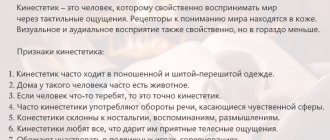Each person perceives the world differently, giving more importance to some feelings and less to others. Based on this criterion, psychologists divide all people into 4 groups: visual, auditory, discrete and kinesthetic. For the first, the main source of information is what is seen, for the second - what is heard, for the third - what is meaningful, and for the fourth, what can be touched is the most informative. Today we will talk in detail about kinesthetics - those who receive the most information and emotions from touch, movements and other sensations.
Who is a kinesthetic learner?
A kinesthetic person is a person who perceives the world around him through body sensations (touch, movement, taste, smell, etc.). A person with this type of perception attaches the greatest importance to physical sensations, remembers them better, makes various associations with them and always remembers first of all what he felt , and not what he saw, heard or thought about.
For example, upon returning from vacation, he will tell you that the food was very tasty, the water in the sea was warm, and the air in the hotel room was cool. At the same time, the landscapes, hospitality of the local population, music, convenience of routes and other features of the resort fade into the background. In life, kinesthetics are most interested in things that give vivid bodily sensations. They are fond of dancing, love sports, prefer to relax in motion, and often choose unusual hobbies such as artistic forging or pottery.
The above does not mean that a kinesthetic person will refuse to go to the cinema with you. Of course, he would prefer to go dancing or to the roller skating rink, but he also loves cinemas, like any other person. At the same time, if you allow him to choose which session to go to, he will prefer something in 3D and always with a maximum emphasis on special effects. In a cinema, it is important for a kinesthetic learner to have a sense of presence, and the sound effects enveloping the body to make the hairs on the skin move.
As a rule, kinesthetics have very well developed coordination of movements and fine motor skills, which usually determines their professional path. In most cases , they prefer work related to movement (choreography, sports career), or choose professions in which they need to do something with their hands (repair of all kinds of equipment, various industries, manual and surgical areas in medicine).
If we talk about learning abilities, then kinesthetics are fine with this. Listening to a lecture or reading a book, they also remember the material quite well, but provided that we are talking about some physical phenomena that can be imagined. If we are talking about logical conclusions or complex theoretical reasoning, which are in no way projected onto sensations, kinesthetic learners quickly begin to get bored and perceive the material much worse.
Content
- Physiological mechanism of sensations
- Types of sensations according to Sherrington
- Properties of sensations
- Sensitivity thresholds
- Sensory disorders
- Adaptation, synesthesia, sensitization
Sense organs are organs that perceive and partially process information that can come from both outside and inside. There are 5 main sense organs: eyes, nose, skin, ears, tongue.
Visual sensations
With the help of the eyes, a person receives 80-90% of information about the world around him. Visual sensations arise when light rays act on the nerve cells of the retina. Rods (130 million) are located on the periphery of the retina; they are responsible for distinguishing between black, white, and gray at any time of the day. Cones (7 million) are located in the center and are responsible for distinguishing color. The mechanism for creating visual sensations: the stimulus acts on the nerve cells of the retina of the eye, excitation occurs, which is transmitted along the pathways to the corresponding part of the brain.
Olfactory sensations
The sense of smell is one of the most ancient and important senses from an evolutionary point of view. Many animals use these sensations to navigate in space, defend themselves from attacks, communicate, choose partners, etc. Olfactory sensations are caused by particles of a substance that fall on the nasal mucosa.
Tactile sensations
Nerve fibers located in every area of the skin send signals to the brain about temperature fluctuations, touch, and pain. The skin perceives vibration, temperature, electrical, chemical, and mechanical irritations.
Auditory sensations
Auditory sensations are caused by auditory waves, i.e. air vibrations from a sound source. The human hearing range is 16-20,000 vibrations per second (16 Hz-20 kHz), higher frequencies are ultrasound, lower frequencies are infrasound. 1000 vibrations per second is normal.
Taste sensations
During taste sensations, particles of objects affect the mucous membrane of the tongue. There are 4 basic tastes: sour, bitter, sweet, salty. The tongue is conventionally divided into several zones, each of which perceives its own type of taste.
Sometimes the vestibular apparatus in the inner ear (sense of balance and sensation in space), as well as muscles, tendons, ligaments (changes in the position of individual parts and the entire body in space, determination of the mass and volume of objects, analysis of movements and their coordination) are added to this list.
The main signs of kinesthetics
Even with a very good understanding of who a kinesthetic person is and what behavioral features are characteristic of him, it is quite difficult to identify a person with this type of perception. Often he himself is not aware of his peculiarity, let alone recognizing him by external signs and habits. And yet it is possible, although this will require communicating with the person often and regularly. Let's look at some of the most obvious signs that identify people who have a predominant kinesthetic type of perception:
- Characteristic words. Since bodily sensations are important to a kinesthetic learner, he often talks about these feelings. His phrases constantly contain the words “soft”, “warm”, “rough”, “silky”, “hot”, “felt” - those that convey certain sensations.
- Pay attention to air temperature and other conditions. Kinesthetic people are sensitive to discomfort. They are the first to notice that the room is cold, hot or stuffy. Strong smells can distract them, making it difficult to concentrate. Therefore, they do not like it when someone in the office has a snack at work.
- Gestures and touches in communication. Communication with loved ones, friends and acquaintances is important for any person. This is not just an exchange of information, but also an exchange of emotions. Therefore, kinesthetic learners, when communicating, gesticulate very actively and often unobtrusively touch the interlocutor (which should not be taken at all as flirting). When they see an interesting object, they try to touch it instead of looking at it.
- Orderly arrangement of things. Kinesthetic learners do not like chaos in the workplace or in personal belongings, since it is more difficult for them to visually find the necessary objects. Therefore, he prefers to know where everything is.
- Restrained behavior. In society, such people behave calmly, often looking immersed in thoughts or their own experiences.
- Profession, hobbies and interests. Pay attention to what a person does, what he is interested in and how he relaxes. If he works as a massage therapist, in his free time he sculpts sculptures from alabaster or collects models, and prefers to relax on the dance floor - you are probably a kinesthetic person.
- Comfortable and practical clothes. As noted above, kinesthetic learners value comfort. Therefore, when choosing clothes, they are guided by considerations of convenience and practicality, completely not understanding why style and compliance with fashion trends are so important for others.
Interestingly, kinesthetic learners are often hyperactive in childhood, but with age they usually become much calmer. From the outside they often look like introverts, but this is not entirely true. They are not withdrawn, they just communicate more calmly than other people. It is often important for them that a loved one simply be nearby, since they feel his presence literally on a physical level.
Human representational system
To begin with, it should be recalled that representation should be understood as the process of representing and expressing certain experiences (thoughts, ideas, etc.) by a person. And a person, receiving information coming to him from the outside world, always relies on his senses. The human body is equipped with a huge number of sensitive receptors, which are the only way to receive information. To put it simply, all human experience is formed by the following sensations (modalities): visual, auditory, gustatory, olfactory and tactile. Besides them, there are others, but they play a secondary role. These modalities are called representational systems in NLP.
Receiving information through our senses, the brain encodes it and then represents it in the form of corresponding data, feelings and emotions, even a small part of which can accommodate a whole range of possible meanings. And a person already evaluates and systematizes these data and values. In short, this is how the process of perception works. But here we should take into account the main presupposition (truth that is not subject to discussion) of NLP - “The map is not the territory,” where the map is a person’s perception of reality, and the territory is objective reality itself.
It turns out that the way a person perceives the information received has only a subjective meaning, not reflecting the objective state of affairs. Each person has his own map, which is the basis of his perception, and this map, due to its individuality, will never become a reflection of the truth. But, knowing that each person has his own map, you can successfully use this, which, in turn, allows you to understand people on a deeper level and convey information in the form in which it will be perceived as accurately as possible. You can also influence a person’s map, thereby changing it.
In general, to be more specific, knowing about a person’s map and his peculiarities of perception, as well as about his map and his peculiarities, you can maximize the level of mutual understanding with others and make any communication as effective, mutually beneficial and productive as possible. And one of the main ways to influence oneself and others is precisely communication based on representative systems. We will talk about them further.
Psychological portrait of a kinesthetic learner
To better understand who a kinesthetic person is and how best to behave with him, it is advisable to understand the characteristics of his psyche. Psychologists identify several character traits characteristic of people with this type of perception:
- Impulsiveness. Despite the characteristic calmness in communication, the kinesthetic person often begins to act without thinking through the consequences and without drawing up any plan. At the same time, he values stability, so he chooses those paths that seem to him the least risky.
- Non-conflict. Emotions for kinesthetics are comparable to physical feelings, and any conflict that may seem like a harmless showdown to other people causes them pain. Therefore, they try to avoid conflicts, and they do this very skillfully.
- Silence. Kinesthetic people speak little, which is why they seem modest and timid to others. In fact, they are simply not very talkative, and when communicating, communication is more important to them than communication.
- Melancholy. This does not mean that all kinesthetic people are melancholic. They are simply so immersed in their thoughts and feelings that they literally do not notice the events happening around them.
- Conservative. People with this type of perception do not like to rebel against established traditions. They prefer the world around them to be as predictable as possible.
It cannot be said that the listed features make a person better or worse for others. You just need to understand and take them into account, in particular, so as not to be offended that your kinesthetic friend did not notice your new hairstyle or the stylishly folded handkerchief in your pocket. But he is a very peace-loving, flexible and reliable person with whom you can build harmonious friendships or romantic relationships.
Physiological mechanism of sensations
The process of the emergence of sensations can be represented as follows. An irritant (music) with certain characteristics affects a certain sense organ (ears), which perceives information and transmits it along conductive pathways to the brain, where this information is processed, and we begin to hear music. This is how the surrounding world is reflected.
Charles Sherrington, an English physiologist, Nobel Prize laureate in physiology or medicine, proposed a classification of sensations according to the nature of reflection and location of receptors.
Kinesthetic woman
Women with a kinesthetic type of perception love to attend various relaxing procedures. They like massages and jacuzzi, they like to spend time in hairdressers or nail salons, and they do not do it for the sake of beauty. just like the tactile sensations associated with these procedures. Therefore, they always have well-groomed skin, nails and hair.
Usually such ladies have good relationships on the personal front, since they are always very affectionate and gentle with their partner. They never forget to hug and kiss him, willingly give him a massage, and pay great attention to caressing his body. Another advantage in relationships with women who have kinesthetic perception is that they do not disperse their attention to the men around them . They wear simple and comfortable clothes and avoid fashionable outfits and bright makeup.
Properties of sensations
1. Modality is a qualitative characteristic of sensations. This is the basic feature of each particular sensation that can distinguish it from another sensation. For example, for auditory sensations this is pitch, timbre, volume.
2. Intensity is a quantitative characteristic of sensations. It is determined by the force with which the stimulus acts on the object.
3. Localization is a spatial characteristic of sensations. A property that indicates the localization of a stimulus in space.
4. Duration is a temporary characteristic of sensations. Indicates the time during which the stimulus was in effect.
Male kinesthetic
Men with a kinesthetic type of perception attach little importance to appearance, both their own and that of others. And yet, when choosing a companion, they pay attention to the shape of her body, skin and hair, since touch is very important to them. At the same time, they prefer ladies who do not overuse cosmetics and perfume, but who are neat and well-groomed.
Such men don’t care much about their own appearance, not trying to look bright and stylish. They prefer simple and comfortable haircuts, most often either clean-shaven or growing a neat beard that does not require complex care and does not cause inconvenience. They prefer clothes that are comfortable and practical, because they are not ready to sacrifice their own comfort for the sake of a stylish look. Kinesthetic men are quite talkative and like to talk about feelings.
How to deal with a kinesthetic learner?
It should always be taken into account that a kinesthetic person is a very calm, tactful and peace-loving, but at the same time touchy person. At the same time, he is not inclined to talk about his grievances out loud, so you will not even know how you offended him. To make the kinesthetic person feel comfortable with you, remember that he attaches special importance to such details as:
- Comfort. Always remember that bodily comfort is more important to him than to you. Therefore, pay attention to the environment in which you spend time together. If you want him to appreciate you and enjoy spending time with you in the future, make sure that he doesn’t feel hot, stuffy or cold around you.
- Touching. Of course, touching should be appropriate to your relationship and not be intrusive. If this is your girlfriend or boyfriend, you need to pay more attention to touching, but it is better not to do this in crowded places. If your relationship is more friendly or friendly, then start paying attention to such moments as the correct handshake - many people today treat this gesture carelessly, completely forgetting its meaning.
- Personal items. Kinesthetic learners don’t like it when someone touches their things, but it’s even worse when someone moves them around. Keep in mind that this can greatly offend them.
- Tasty food. The way to the heart of a kinesthetic learner truly lies through the stomach. He pays less attention to the beautiful presentation of dishes, but subtle notes of taste and texture features are very important to him.
- Comfortable clothes. Such people like comfortable clothes, and they also love active recreation. They are always ready for it, and choose clothes accordingly. And if you’re going to the cinema with a kinesthetic student, he won’t be at all upset if along the way you decide that it’s better to go rollerblading. Therefore, when going to a meeting with him, you should dress more practically.
Sensory disorders
1. Sensory hypopathy is a disorder of sensitivity in such a way that both weak and strong stimuli are felt weakly.
2. Sensory hyperpathy is a sharp increase in the intensity of sensations when exposed to weak stimuli.
3. Paresthesia is sensations without stimulus (numbness, tingling).










